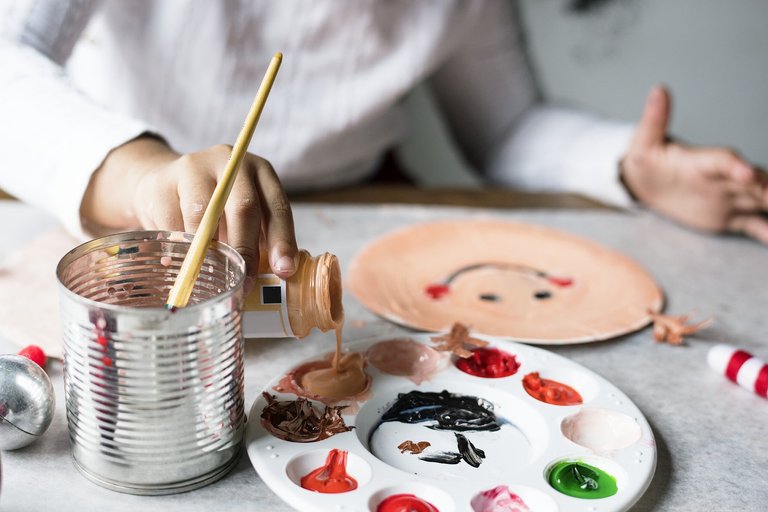
Art was very important to me when I was a child. The art programs where definitely lacking in quality though. It's not a surprise that the football team always seems to get all the money. All forms of art, painting, music, acting, ext. are greatly underappreciated in our schools. Painting pictures is one of humankind’s basic means of expression that should continue throughout all grades. Art is an experience that should occur frequently in order to develop the child’s confidence in his or her ability to express ideas through art. Such pictures may tell a story or may be non-objective arrangements of colors and forms that are pleasing to students. The paints used in school by young children are generally water-soluble. All can be called watercolor, but there are two major types — opaque and transparent.
Opaque water color: It is called opaque because, when used at the proper consistency, it hides the surface on which it is painted. It is known by various names — showcard, poster or tempera paint. This paint is more suitable for young children than transparent watercolor because it is more easily controlled and it permits one color to be painted over another to meet the child’s immediate need. It comes in liquid and powder form The liquid form of tempera is supplied in a variety of colors in pint jars. Mix the contents of the jar thoroughly by stirring. Test the paint before using it. If it is too thick, it will crack and peel when dry. If it is too thin, it will not cover properly. When it appears too thick to brush easily, add water to it gradually and mix it thoroughly until the desired consistency is obtained. Liquid tempera contains a preservative and will remain in good condition if kept moist and tightly covered. To store paint that has been opened, add a little water and wipe the rim of the jar before replacing the lid. Stir it again before using. This is the form of opaque watercolor used most commonly in these grades. The dry powder form of tempera is supplied in one-pound packages and keeps indefinitely. It is usually less brilliant than liquid tempera. Prepare it for use according to the directions on the package.
The following suggestions may be helpful: Use a wide-top jar, half-filled with paint powder. Add water gradually while stirring thoroughly. Cover the mixture and allow it to stand overnight. Then pour off most of the excess water and stir again. Add more water if needed. A drop of oil of cloves may help prevent a bad odor. A teaspoon of liquid tempera or a little powder paste can help bind the color to the paper. This paint will not keep very long after it is mixed with water.
Transparent water color: It is called transparent because the color of the paper shows through and modifies the color of the paint. The watercolor box contains eight small pans of color. It is not generally recommended for children of these ages because the technical problems of controlling it can make it difficult for young children to use. Distributing tempera paint Reserve the original jar to supply paint to smaller containers for children’s use. The paint should be supplied to the children at the proper liquid consistency and in sufficient quantity and colors for the particular art experience. Various methods meet various needs. Experiment with juice cans, milk cartons, muffin tins, etc. Distribute the paint in the way that is most convenient for your situation. Two versatile methods follow.
Palettes: These are made from folded manila tags and are good for individual use when colors are limited. With a plastic squeeze bottle or a spoon, distribute small quantities of very thick paint. Replenish paint as needed. Palettes are folded and discarded at the end of the lesson. Other supplies for painting Papers: They should be strong enough for vigorous brushing and large enough for free, sweeping brush strokes. Suitable papers are newsprint, manila, bogus, gray drawing, colored construction and brown wrapping paper. A useful size is 18” x 24”. If an entire class is painting and space is limited, 15” x 18” paper may be used.
Brushes: The #6 wash brush, or one of similar size, is useful for all purposes. The #7 brush may be used by older children for details. Small sponges: These are used in printing, painting and cleaning. Jars of water: When painting from a palette, water is needed to moisten paints to brushing consistency. Older children will need water with each set of paints in order to clean brushes between colors. Buckets and pitchers: These are used for a supply of water if the room has no sink. An extra bucket permits the emptying of dirty water. Easels: One or more should be constantly available for large painting and drawing. Each child should have repeated turns at the easel. Desk boards: These are available in two large sizes. If space is limited, they may be used instead of easels for classwork. Paintings clipped to them can stand against the wall to dry. Clips: These are used to hold paper to the easel or the desk board. Protection materials: Most liquid tempera colors do not stain, but all working surfaces and clothing should be protected when this paint is used. Newspapers, oilcloth or plastic material are appropriate for protecting work surfaces. Newspapers are most convenient because they may be discarded at the end of the class and require no special cleaning. Use aprons or smocks to protect clothing. For more information on the art curriculum for elementary students visit www.philasd.org.
Hi! I am a robot. I just upvoted you! I found similar content that readers might be interested in:
http://www.phillytrib.com/the_learning_key/painting-for-elementary-students/article_39bc693e-c618-5706-a143-4891405790ae.html